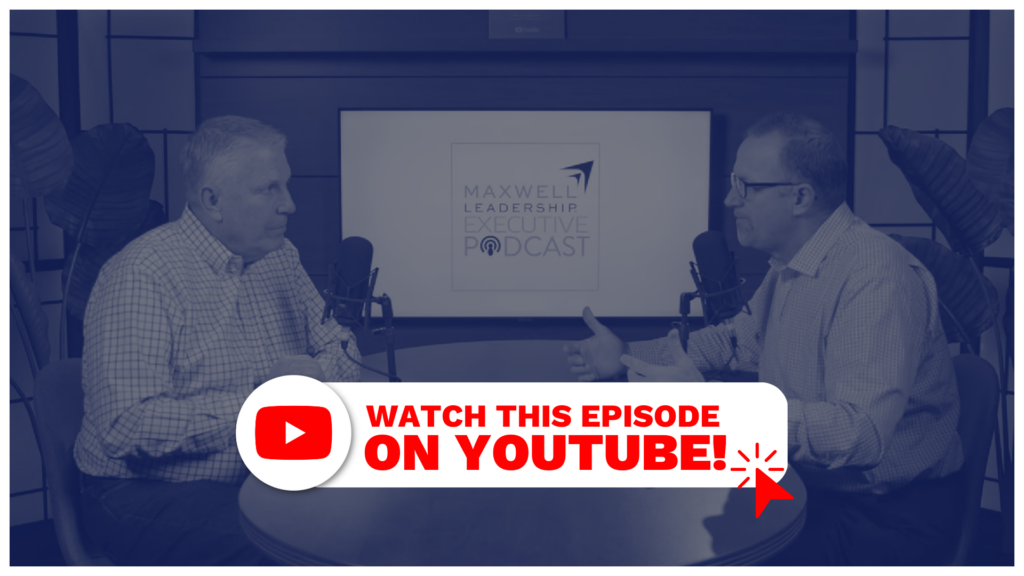Executive Podcast #231: 16 Undeniable Laws of Communication (Part 2)

John has a new book ready to hit the shelf on March 28, 2023 that every one of us needs to put to work in our business and professional lives. Everyone can learn and grow in the area of communication.
The book is, The 16 Undeniable Laws of Communication – Apply them and make the most of your message.
Today we are looking at Law #7 – The Law of Connecting. Communicators know It’s All About Others.
John makes is very clear that The Law of Connecting is by far the most important idea in this book.
Get FREE advance access to Chapter 7 here!
Perry Holley:
Welcome to the Maxwell Leadership Executive Podcast for our goal is to help you increase your reputation as a leader, increase your ability to influence others, and increase your ability to fully engage your team to deliver remarkable results. Hi, I’m Perry Holley, a Maxwell Leadership facilitator and coach.
Chris Goede:
And I’m Chris Goede, Executive Vice President with Maxwell Leadership. Welcome and thank you for joining. We’re excited about today. We’re going to have a second session, part two of an episode that we spent some time last week on around John’s brand new book that is going to be released on March 28th as Van White is showing it. For those that are not on YouTube, you need to go on YouTube just to check out Perry sharing the book with you. But we have a copy here and matter of fact, I didn’t even know that was in our office until I saw it on the-
Perry Holley:
I know people.
Chris Goede:
You do know people when it comes to books and to learning and to growth. So we’re excited about diving into that. First, if you want the Learner Guide and you’re going to want the Learner Guide because we have a special surprise for you that’s going to be in the Learner Guide. You want that. I need you to go to maxwellleadership.com/podcast. You can download that Learner Guide there and then also leave any questions or comments you may have, whether it’s around the laws of communication that we’re going to talk about or we talked about last week, or just the leadership in general that would be awesome for us as we move forward and develop content for you guys.
Well, today’s topic, as I mentioned, we’re going to build off of what we did last week. This is the 16 Undeniable Laws of Communication part two, and we started this conversation last week. Remember the subtitle of John’s book here is, How Do I Apply Them and Make the Most of Your Message? So how do I apply these laws? And then that will make the most of the message that you’re communicating. Last week we talked about law number one, the law of credibility. Your most effective message is the one that you live. Perry, what are we going to expose them to today that you kind of dove into this book and were able to read the manuscript before it got released and talk about some of the details behind the content.
Perry Holley:
Yes, I love this, and as we mentioned last week, everyone could grow as a communicator. It’s just something that you need to constantly be working on yourself, improving your message. We want to reduce any in intention interpretation gap, intention perception gap about you intended it one way, somebody else perceived it another. And you have made a great point that that’s the leader’s job. My job is to shrink that gap so that we are understanding each other. I will place the table of contents in the Learner Guide, so you can see all the chapters. But just a reminder that it’s broken into five sections around who said it, what was said, how it was said, when it was said, why it was said, and there are a number of laws under each one of those. And today I wanted to specifically drill down on what would be law number seven of the 16 undeniable laws.
And that was from the section on how it’s said and seven is the law of connecting. And the law of connecting reads that communicators know that it’s all about others. And I’ll just give a spoiler alert. John says, “All the laws are independent, they stand alone, but this is the law that would be the most important of the 16. You better get this one right.”
Last week we were talking about your credibility. This week’s really about connecting and if you’re not connecting with others. So this is been one of, I think one of my personally biggest areas of growth over the last 10 plus years as I’ve gone into professional communications from in front of audiences in front of small groups, one-on-ones with coaching is that at home really figuring out that, putting another spoiler alert is that this is all about putting connection over content. I think that’s a big learning for me. This is that can you make the connection with the person superior to whatever content you have to communicate? Can you communicate in such a way that you protect the connection?
Chris Goede:
And so many communicators want to put the emphasis on the content. Wait till I tell you what I have to tell you. That’s where they want to go. And they put the emphasis on that. And they believe that that content has more value to those that are receiving the communication than actually the connection. And that’s not true. And I’ve seen this for so many years with John, just being able to sit right there on the front row with him in so many different events. And the first thing that he does is how can I connect to this audience? Or if we’re in meetings, how can I connect to our guests that are in the meeting? And he lives this out. And that’s why I could see him saying in the book, this is it. This is the most pivotal part in all of that.
And good communicators know that connection is more important than the content. When you listen to somebody who’s talking to others you know immediately you can feel it and you can sense it what they value. And it’s either they value themselves and the story about themselves. Let me tell you how good I am, the content or the audience. And it reminds me of a story that John talks about where he had this young speaker communicator come up to him and say, right before John was getting ready to go on stage, “What are you thinking about right now? What are you going to tell them?” And John has been doing this for a long time, sits back and goes, “I have an idea, but I’m not sure yet what they want to hear from me. And I’ll kind of go where they need me to go because I’m here to serve them.”
And I know that that young communicator was probably freaking out because it would be completely opposite of what his outline was. So until you connect with the people, there’s a barrier between you and them, and they’re not going to be able to gain as much knowledge or wisdom or just the content. They’re not going to be able to hear it unless you be able to connect with them.
And so you need to make sure that you are focused on that and that the perception of the people is that you want to connect with them. I’ve also heard John talk about how, and you do this a lot when you’re in front of thousands of people, he’s communicating to the one individual at the table to the right, and then he moves over here and he’s connecting and communicating to the one individual over here. And it’s just amazing to watch how he just draws the entire audience in through that connection.
To be a Successful Leader, You Need Feedback on Your Leadership.
We’re excited to announce our new and improved Organizational Effectiveness Survey (OES). The OES gathers feedback from employees to give leaders and management the knowledge and action plans needed to develop a more effective and productive work environment. Our new version measures 4 areas of your business: Leadership, People, Strategy, and Performance.
Perry Holley:
Well, he says in the book I was interested, he said, “Without connection, others may be interested, but they’ll never be inspired.” And you’ve heard John say many, many times that people do not care how much you know until they know how much you care. So again, going back to that individual connection with people, let them know that you care and I’m doing this for you and making that connection. So why don’t you take us through, we’ll get started with what he’s got for us here.
Chris Goede:
Well, as we dive in, your influence is showing up again on John in this book. John gives us five keys to be aware of, to consider as we begin thinking about connecting with people. Number one is realize you are not the main attraction. What is going on with that? The entire population of the world with one small exception, is composed of other people and not just about you. And it goes back to even just the illustration I shared just a minute ago about that young communicator coming up to John and being like, “Man, I can’t wait to tell them what I got to tell them.” And about me. And it’s not about you. You are not the main attraction. And you need to realize that as a communicator.
Perry Holley:
Man. Oh man, was this a tough lesson for me? Probably boy, 10, 12, 15 years ago, I was traveling with a guy, many of you may know, Dr. Jack Zenger. He’s written many books. He’s a rockstar in the space of human development. He’s just fantastic. But he invited me to speak and it was the biggest honor for me. But on the third night of a five night speaking trip, he said, Can you tell a difference when you’re on and when you don’t have it, when you’re off on the stage?” I thought he was going to share, it wasn’t about me I thought it was some lesson. I said, “Yeah, there are times I can tell when I’ve got it, when I don’t.” He goes, “You want me to tell you the difference?” And I said, “Yeah, what?” He said, “On the nights when you feel like you’re off, you didn’t have it I’ve noticed that you were completely focused on you, yourself. You were completely focused on how you look, how you sound. Do I sound smart? Do I look good? Is my tie straight? Are people are impressed with me?”
And I was starting to backtrack a little back and he goes, “But on the nights you’re on, I’ve noticed that you’re completely focused on what you can give to the audience.” And I went, “Well, I never thought about it.” Actually, I rejected it and argued a little bit, but then I thought about it later and go, he’s exactly right. I have made it about me and I’m worried about how I look. And I was sweating and nervous and anxious. But the minute I started adopting this little lesson he gave me, which was make it about the other person or make it about the group or make it about the audience.
And don’t worry. Do I want them to think I look good? Yes, but that’s not why I’m here. Do I want them to think I sound smart? Yes, but that’s not why I’m here. I’m here to add value to you, to give you some nugget of truth that you can leave here and be better after having been with me. And once I got that, I stopped sweating. I stopped being nervous. I started going in kind of meditating over this empty seat about who’s going to be sitting here, who’s going to be… Thinking about the groups that we coach? What do they need? What are they looking for? How can I help them? The individuals that we talk to, what is this? How can I serve you? How can I speak to you and do that? And it just changed everything for me. All right.
Chris Goede:
That was good.
Perry Holley:
Was that was too much about me?
Chris Goede:
No, that was good. That was good.
Perry Holley:
Number two, make your first impression your best impression. Science tells us that people make a judgment about you in about seven seconds. Whether in front of a large audience or one-on-one, you’re always making people feel something and are you aware of what you make people feel? And could you on purpose, make people feel something on purpose?
And I think one of my bigger lessons here was I just said, mind your face. My wife said, “You’re very intimidating.” I don’t want to be intimidating. “Well, you’re a different person when you smile.” Oh, okay, then maybe I should smile more. I think you do this really well. When you enter a room, when you join up with one or many, you have a great way of making a great first impression. Is that intentional? Have you done that on purpose are you studying that? Or is that just your natural charisma?
Chris Goede:
Well, I think it’s being around John for so long has just rubbed off on me. I think about when you ask that question. I think around the statement that he says, “Walk slowly through the crowd.” And he does that and he smiles and he shakes hands and makes eye contact. And so I think just years of being around John and watching him do this and watching him make first impressions and connect with people, it’s become part of a learned behavior of mine. And so I think that’s probably where that comes from. And I try to do that, whether it’s in a one-on-one situation or whether it’s with a team or a large group. And John also talks about 25 ways to win with people, the 30 second rule, where he says, “Hey, basically within the first 30 seconds of the conversation, find something about that individual that you can say that encourages them, that speaks encouragement into them.”
What is that? Now, do it authentically. I’m not saying just to do it, just to make that statement have pure motive, but I think if you keep those things in mind. My biggest problem in doing that is walking slowly through the crowd. Because sometimes I get focused, sometimes I get on an agenda, and sometimes I just kind of will speed walk through.
And I had a friend of mine several years ago who actually observed me doing that, pulled me aside a couple days later and said, “Man, you must have a lot going on.” And I was like, “Why?” He goes, “Well, I watched and observed you through the crowd a couple times, and it was very unlike you to where you kind of had your head down and you were fast-paced and didn’t even acknowledge the people around you.” And it really struck me and it hit me. And so even as busy as I am, I try to still make sure, and I think that’s just a great way to be able to make a good first impression.
Perry Holley:
That brings up an interesting… Because you know and I are, if you think about some people are task based and some people are relationship based, it’s a personality and temperament thing that some people are more quiet and reserved. Some people are louder and not reserved. That would be me and you. So it’s a little easier. What do you think about, to me this is a great one to think about, you’re going to make people feel something. If you are that task-based, reserved, quiet person, could you intentionally, like what you said about walking slowly and maybe putting my task on the backseat for a moment and forcing myself to be relational for a moment, to get the first impression, to let people see you, to let them experience you, and to feel something positive about you before you get to the task.
Chris Goede:
Yeah, it goes back to the old managing by walking around. And even if you have a tendency and you’re wired perfectly, how you’re wired to be a little bit more reserved, that just put a smile on your face. I love that. Mind your face. Mind your face. The smile will just connect with people and have a good first impression.
Maxwell Leadership Growth App:
Hey, podcast listeners, do you have a clear plan for growth? Achieving big results most often does not require big life changes. Small improvements over time compound into big results? Download the Maxwell Leadership app. It’s the new free app where our expert guides and John Maxwell help you pace your leadership journey and set a clear plan for your own personal growth. You can also find all sorts of resources on the Maxwell Leadership app, including this podcast, information on upcoming events, and much more. Just search Maxwell leadership in your app store and download the app today.
Chris Goede:
There’s also another phrase around where those that are listening, I won’t spell it out for you, but it could be that you have a resting serious face. I’ll use a couple of other words that we may have not used with my children as they were growing up. But I think that’s key with that first impression around that smile.
So well, number three is be intentional in seeking to understand their world. When you are connecting with people and you’re speaking to them, people are either thinking, man, so what? Or me too. The lesson that I really want to pull out here for me, and this is just a personal lesson from our event, which we do an event every year called Exchange, and it’s a fantastic event. It’s two and a half days of leadership content communicators and speakers, but also we try to stretch the limits and bring to the table some leadership experiences.
Well, this is an event that I have a privilege of leading an incredible team on. And this past year we did it out in San Diego and we were doing some work with our Navy SEALs out there. And we thought, man, this will be awesome. We’re going to have about 120 people. We’re going to take them out and let’s let them experience on the beach, what it’s like to go through [inaudible 00:15:47] all this stuff. So the day before I met with John and I said, “John, this is going to be awesome. Our team feels really good about it. I feel good about it, but we’re still getting a lot of negative feedback. We’re still getting a lot of concerns. Can I do this? And I don’t want to be a part of that and [inaudible 00:16:06] this up.”
And John sat me down and he said, “Here’s what I want you to do.” He said, “I literally want you tomorrow to get up there before we even get started in the whole day. And just comfort them and say, Hey, man, no, I’m feeling the same way you’re feeling, but trust me, it’s all going to be okay. There’s going to be a place for all of us to participate.” And it’s that whole kind of, oh man, me too. I do not want to go do this. And it was just a great lesson because then John sat on the front row and watched me communicate that which was a little bit fearful, and then afterwards I said, “Hey, coach me on that.” And it was just around, Hey, put yourself in their shoes so that they are going, man, he really does understand my world. And so that’s just a great lesson for me. So how do you do this though? You speak to bigger and larger audiences more than I do. How do you do this with the audience if there’s so many people in there, really trying to understand their world?
Perry Holley:
So much of this starts with before the event or before you speak. Of course, if you’re speaking one-on-one with people on your team, you should absolutely know what’s going on in their life. Where are they? Who are they? What’s their experience? You’ll do this as building relationship.
If you’re speaking to a larger group, I always come in ahead of time with the sponsor. I ask them to bring me up to speed on who this audience is. Why are they here? What are you expecting? What have they seen before me? What are they going to see after me? What are their strengths and their struggles? In this environment we’re having right now in this economy what’s going on? What could I possibly do to add value to them? I love to arrive early, meet, touch, and talk. I talk, just greet and understand people, to shake as many hands as I can, to ask some questions, to connect if possible to do that.
Jim Rowan said, I always thought about this was “Start where people are before you try to take them where you want them to go, I need to know where are you?” And to me, it’s kind of identifying a gap. I know I’d like to take you, but where are you? And then I can teach or coach to that gap, and that makes it easier to add value to people when doing that.
Number four was be personable. Are you likable? People don’t want to listen to you if they don’t like you, how does one make themselves more personable?
Chris Goede:
Well, John teaches the approachability principle in a book that he wrote called Winning with People. We actually have a development course for some of our teams around this same thing as well. And I think being at ease with yourself helps other people be at ease with you. You’re not trying to put on a front. You’re not trying to be somebody that you’re not. You’re not trying to lead like Perry or lead like Chris. You want to communicate and lead the way that you are and be at ease with that. And so when you do that, you become very real to other people and you connect and you’re personable with them. As I mentioned, and we talked about this earlier, I think when you understand their world, you can connect with them and you can find common ground. There’s a statement that says, “There’s a connection between all of us somewhere, maybe it’s only 1%, but find that 1% and then go a hundred percent in on that 1%. And when you do that, there’s going to be that approachability and that connection there with each other.”
I was with a team on Friday and I was spending the entire day with them kind of going through the five levels of leadership when we were doing a workshop and a training with them. And one of the questions was like, all right, what if I absolutely have nothing in common and don’t even want to speak to so-and-so on my team? And the first question I said, “Well, is that person in this room? Because if it is, we might have another conversation.” “No, no, no, no, no.” And so we talked about this 1% principle and then go a hundred percent in, which is what reminded me of it.
All right, well, the last one, number five John talks about here is develop charisma and some think that charisma is something that you are born with or you’re not. You either have it or you don’t. John says, this is actually a choice, and that charisma is present in people who focus on others first.
Perry Holley:
John teaches the charisma principle again in Winning with People and that people are interested in people who are interested in them. And I’ve seen this firsthand where I was at a reception, my wife was there, she had wandered away, and I’m talking to three people and I just asked a question, and then they tried to ask some me, but I turned it back to them and I just started using some of them, I was kind of having a little fun saying, “Tell me more. And then what happened and what happened next?” And I just kept drawing more and more out of them. And then after seven or eight minutes, my wife returned and we departed, and the guy looked at my wife and said, “Your husband is a master communicator.” And so we walked a little further and she said, “A master communicator, what did you do?”
I said, “That’s funny. I didn’t do anything. I hardly said a word.” But they did all the talking and it’s amazing how people will respond when they know… You hear that charisma is a choice. It’s not this over the top bubble. It is really a connection with people that says, I care about you. I said, “What did I do? I was totally present. I listened to their story. I encouraged them to tell more of their story. I made them feel seen.” And they credit it to me being a great communicator when I probably said seven words to do that. You think we do that all the time, but our default mode is usually about me, and I have to really be intentional to focus that outward and to make that connection.
Chris Goede:
And always fight the urge to one up their story or what you’re hearing from them. And I love your approach of asking questions. Do it authentically, please. We’ve talked about this. I want to underline it. Do this with the right motive and be authentic. Well, as I wrap up, again, we’re talking here about chapter seven in John’s newest book that that’s coming out March 28th. Perry’s going to tell you in just a minute how you can actually download this chapter, chapter seven, in the show notes or the Learner Guide. So hang with us and he’ll share that information with you in just a minute.
Talking about law number seven, the law of connecting and what we reviewed as I wrap up here. Number one, realize you are not the main attraction. If you were still listening after that point, number two was make your first impression your best impression. Number three, be intentional in seeking to understand their world. Be curious, be curious about other people. Number four, be personable. And then number five, develop charisma.
Perry Holley:
Terrific, Chris. Well, thank you. And a reminder, if you would like to know more about our offerings or leave us a question or a comment, you can do all that at maxwellleadership.com/podcast. You can also go to the show notes where there will be a link for you if you’d like to learn how you could download this chapter, chapter seven, for your own use, and you can see that there on the show notes.
You can also, the Learner Guide for this episode, you can download that. I put the entire table of contents there as well as the notes from today’s recording. And also a QR code there for you to use if you’d like to, again, download the chapter that we’ve been talking about. There’s a lot there for you. Hope that you’ll take advantage of that. Please leave us a question or a comment. We’re so grateful to hear from you and we’re very grateful that you would spend this time with us. That’s all today from the Maxwell Leadership Executive Podcast.













Be the first to comment on "Executive Podcast #231: 16 Undeniable Laws of Communication (Part 2)"